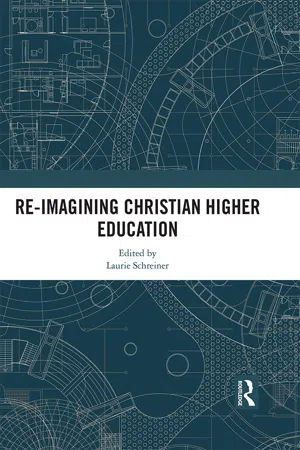
- 124 pages
- English
- ePUB (mobile friendly)
- Available on iOS & Android
Re-Imagining Christian Higher Education
About This Book
Re-Imagining Christian Higher Education takes a fresh and critical look at the challenges facing Christian colleges and universities and provides concrete recommendations for university leaders, faculty, and staff to implement in their daily work. Chapters in this book address leadership and diversity challenges, issues of affordability and sustainability, and ways of maintaining the distinguishing features of a Christ-centered liberal arts education. A vivid and compelling picture of the Christian university of the future is painted by these authors as they highlight the importance of embracing our Christian identity while being willing to engage a pluralistic and fragmented world. Firmly rooted in a missional identity of faithful learning that is committed to the intellectual, personal, and spiritual development of our students, Christian colleges and universities are encouraged to reclaim and revitalize the breadth and depth of the Christian tradition in order to move forward.
The chapters in this book were originally published as a special issue of Christian Higher Education.
Frequently asked questions
Information
Steering the Ship through Uncertain Waters: Empirical Analysis and the Future of Evangelical Higher Education
Approach and Methodology
| Indicators | IPEDS measures |
|---|---|
| ACCESS | |
Percent of African American students | Formula: Full-Time Students, Undergraduate Total, Black or African American Total/Full-Time Students, Undergraduate Total, Grand Total |
Percent of Asian students | Formula: Full-Time Students, Undergraduate Total, Asian Total / Full-Time Students, Undergraduate Total, Grand Total |
Percent of Hispanic students | Formula: Full-Time Students, Undergraduate Total, Hispanic Total/Full-Time Students, Undergraduate Total, Grand Total |
Percent of White students | Formula: Full-Time Students, Undergraduate Total, White Total / Full-Time Students, Undergraduate Total, Grand Total |
Percent change in total student enrollment | Formula: (Full-Time Students, Undergraduate Total, Grand Total: Fall 2013—Full-Time Students, Undergraduate Total, Grand Total: Fall 2010)/Full-Time Students, Undergraduate Total, Grand Total: Fall 2010 |
Percent change in African American student enrollment | Formula: (Full-Time Students, Undergraduate Total, Black or African American Total: Fall 2013—Full-Time Students, Undergraduate Total, Black or African American Total: Fall 2010) / Full-Time Students, Undergraduate Total, Black or African American Total: Fall 2010 |
Percent change in Asian student enrollment | Formula: (Full-Time Students, Undergraduate Total, Asian Total: Fall 2013—Full-Time Students, Undergraduate Total, Asian Total: Fall 2010)/Full-Time Students, Undergraduate Total, Asian Total: Fall 2010 |
Percent change in Hispanic student enrollment | Formula: (Full-Time Students, Undergraduate Total, Hispanic Total: Fall 2013—Full-Time Students, Undergraduate Total, Hispanic Total: Fall 2010)/Full-Time Students, Undergraduate Total, Hispanic Total: Fall 2010 |
Percent change in White student enrollment | Formula: (Full-Time Students, Undergraduate Total, White Total: Fall 2013—Full-Time Students, Undergraduate Total, White Total: Fall 2010)/Full-Time Students, Undergraduate Total, White Total: Fall 2010 |
Percent of Pell Grant recipients | Variable: Percent of Full-Time First-Time Undergraduates Receiving Pell Grants |
| AFFORDABILITY | |
Annual tuition and fees | Variable: Published In-State Tuition and Fees |
Average institutional grant per student | Formula: (Institutional Grants [Funded] + Institutional Grants [Unfunded])/12-Month FTE |
Percent of students receiving institutional grants | Variable: Percent of Full-Time First-Time Undergraduates Receiving Institutional Grant Aid |
Total price | Variable: Total Price for In-State Students Living on Campus |
Average net price for students receiving financial aid | Variable: Average Net Price—Students Receiving Grant or Scholarship Aid |
| STUDENT OUTCOMES | |
Retention rate | Variable: Full-Time Retention Rate |
4-year graduation rate | Variable: Graduation Rate—Bachelor Degree within 4 Years, Total |
6-year graduation rate | Variable: Graduation Rate—Bachelor Degree within 6 Years, Total |
Average amount of annual student loan debt | Variable: Average Amount of Student Loan Aid Received by Full-Time First-Time Undergraduates |
| FINANCIAL SUSTAINABILITY | |
Acceptance rate | Variable: Percent Admitted—Total |
Yield rate | Variable: Admissions Yield—Total |
Net tuition per student FTE enrollment | Formula: (Tuition and Fees—Total + Allowances Applied to Tuition and Fees) – (Institutional Grants (Funded) + Institutional Grants [Unfunded])/12-Month FTE |
Discount rate | Formula: (Institutional Grants (Funded) + Institutional Grants (Unfunded))/(Tuition and Fees—Total + Allowances Applied to Tuition and Fees) |
Tuition dependency | Formula: (Tuition and Fees—Total + Allowances Applied to Tuition and Fees) – (Institutional Grants (Funded) + Institutional Grants (Unfunded))/Total Expenses—Total Amount |
Endowment to operating budget ratio | Formula: Value of Endowment Assets at the End of the Fiscal Year/Total Expenses—Total Amount |
Table of contents
- Cover
- Half Title
- Title Page
- Copyright Page
- Contents
- Citation Information
- Notes on Contributors
- Introduction: Re-Imagining Christian Higher Education: Hope for the Future
- 1 Steering the Ship through Uncertain Waters: Empirical Analysis and the Future of Evangelical Higher Education
- 2 Women in Leadership: The Future of Christian Higher Education
- 3 Pathways to Success for Students of Color in Christian Colleges: The Role of Institutional Integrity and Sense of Community
- 4 Faith and LGBTQ Inclusion: Navigating the Complexities of the Campus Spiritual Climate in Christian Higher Education
- 5 The Future of Residence Life and Student Affairs in Christian Higher Education
- 6 A Distinctive Vision for the Liberal Arts: General Education and the Flourishing of Christian Higher Education
- 7 Reimagining Christian Higher Education
- 8 Envisioning the Future of Christian Higher Education: Leadership for Embracing, Engaging, and Executing in a Changing Landscape
- 9 Toward a Future for Christian Higher Education: Learning from the Past, Looking to the Future
- Index